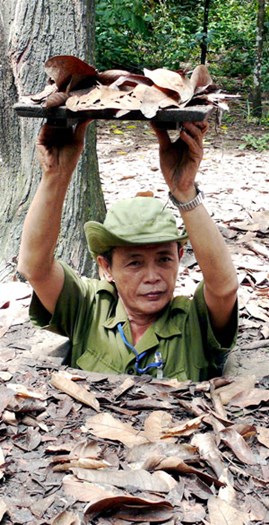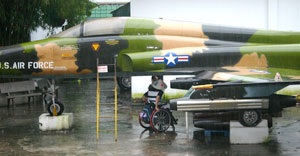CU CHI, VIETNAM – It’s not hard to pick out the tourists brave enough to have crawled through one of the narrow tunnels that were used so successfully by Viet Cong guerilla fighters in the Vietnam War.
They’re the ones with the clay-coloured streaks running down their backs – a souvenir picked up when their backs scrapped against the ceiling of the cramped tunnels.
“Do you suffer from claustrophobe?” asked the young attendant who greeted me at the entrance of a 30-metre section of tunnel now used to show tourists from where the guerillas would launch their deadly attacks against American forces before disappearing again into cavities carved out beneath the thick jungle landscape.
Of course, the tourist portion of tunnel has been widened to accommodate what my guide Kong called “your Mcdonald’s bum.”
A guide leads the way through the tunnel with a small flashlight. It quickly becomes clear why he asked if I was claustrophobic. Even though the tunnel has been hollowed out to accommodate by super sized physic, it’s still tight and I can barely move. The oppressive heat in the tunnel made me sweat profusely so I stopped to wipe my brow with the iconic checkered Viet Cong headscarf I purchased for just a dollar a few minutes earlier.
The light from the flashlight appeared to be getting smaller as the much smaller guide pushed well ahead of me.
“Excuse me,” I shouted out, reminding him that I was still there.
Finally, we reached an opening and the guide asked if I’d like to go further?
I sucked up the fresh jungle air pouring into the small opening and without answering the guide, pushed past him onto a ladder and into daylight.
Kong was waiting and laughing.
“Just think,” he said, “the Viet Cong lived in tunnels that were no higher than 80 centimeters and no wider than 60 centimeters for up to 10 years.”
“Then they deserved to win the war,” I gasped.
The Cu Chi tunnels, located about 65 kilometres from Saigon, have become a major tourist attraction and an outdoor museum of the war which lasted almost 10 years and led to the reunification of North and South Vietnam under the communist leadership of Ho Chi Minh when the Americans abandoned Saigon.
Now, over 1,000 people daily visit the site located in this small farming community from where many of the Viet Cong fighters were recruited because they knew the surrounding jungle terrain so well.
The tunnels were first started in the 1940s when the Viet Cong were established to fight their French occupiers. At the end of that conflict, the tunnels stretched 48 kilometres and consisted of just one level. By the end of war with the United States, however, the labyrinth of tunnels covered over 200 kilometres and consisted of three levels.
“The tunnels were very sophisticated and try as they might with their big bombs, the Americans were never able to do much damage to them,” said my guide as we walked around the site pockmarked with craters left behind by the thousands of bombs dropped on this area from U.S. B-52 bombers.
The Americans even set up a special unite called Tunnel Rats – made up of South Vietnamese and slender GIs – who would be sent into the tunnels to try and capture the Viet Cong but to no avail.
Cu Chi offers a fascinating insight into a conflict which still haunts Americans. Many of the daily visitors here are ex-GIs who served in Vietnam and some need comforting from love ones as they walk around the site and relive the horrors they witnessed in an area were over 6,000 Viet Cong were killed and another 1,600 civilians perished.


Left: A guide pops out of a Vietcong tunnel. Right: A U.S. veteran visits the Vietnam war museum.
“We don’t know how many Americans were killed here but the fighting was always very intense because Cu Chi is so close to Saigon, where the American Army was based,” said Kong, whose father fought with the South in the conflict that cost over 50,000 American lives and changed U.S. foreign policy forever.
There are only two sections of tunnels still open - here and at Ben Dinh. The rest were sealed after the war because villagers were fearful their children would crawl into them and be attacked by the scorpions and pythons who like the damp, dark quarters.
The site gives a great insight to the determination of the Viet Cong fighters, who are today considered martyrs by the Vietnamese.
“In addition to the tunnels, they built a whole town underground,” said Kong. “There were hospitals, kitchens, meeting rooms, dining rooms, a factory for making clothes and weapons and even wells were dug out.
“That is why the Viet Cong could live so long underground without the Americans knowing they were there,” said Kong, who stopped at a bamboo hut where elaborate booby traps used against the Americans were on display.
Trap doors hidden beneath jungle foliage would open when stepped on and send a soldier into a pit filled with sharpened bamboo spikes. A variety of other deadly traps were also on display, including one that was meant to spring from a tree and catch a GI in the genitals.
"No more babies after being hit by that,” said Kong.
The site was littered with bomb casings left behind from the fighting and an old U.S. tank that was destroyed when it hit a land mine.
In the distance we heard the pop, pop, pop of gunfire.
“Don’t worry, war has not broken out again,” laughed Kong. “The shooting is coming from the range set up to allow tourists to fire guns used by the Viet Cong.”
The shooting range is a hit with tourists who buy bullets for about $2 U.S. – minimum five bullets – and then, under the watchful supervision of attendants, fire mounted AK47 rifles and M-60 machine guns – the weapons of choice of the Viet Cong.
Cu Chi is also a place where the country’s coveted rubber trees flourish.
“The rubber trees were one of the reasons the French occupied this area,” said Kong. “They used the Vietnamese farmers as slaves and worked them until they died. Then they would bury their bodies under the rubber trees to be used as fertilizer.” For a country that has a 2,000-year history of conflict – first with the Chinese, then a civil war, then with the French, the Americans and a few spats with neighbours like Cambodia in between – it’s not hard to find places here that showcase the horrors of war.
One place in particular that offers a true insight into the Vietnam War is the War Remnants Museum located in downtown Saigon. Through a series of shocking photographs taken by journalists from both sides that covered the war, many of whom perished in the fighting, visitors see the horrors suffered during that period.
In the first of six rooms, mostly black and white photographs depict wounded and killed American soldiers while in the second, the horrors inflicted on Vietnamese and Viet Cong troops are showcased.
The most disturbing room is No. 3, though. That’s where the story of civilian victims of the war is told through dramatic pictures showing the distorting effects on the human body from Agent Orange – the chemical weapon used by the Americans to clear jungles of foliage so they could scout Viet Cong activity – and victims of napalm bomb attacks, including the Pulitzer Prize-winning photograph of a young Vietnamese girl running naked with her body on fire after one such attack. The museum is obviously not complementary to American forces and showcases atrocities they committed against the Vietnamese, like the My Lai Masscare, where an entire population of villagers, including women and children, were gunned down.
The museum courtyard is littered with vintage U.S. tanks and planes and is filled each day with mostly American tourists who gasp at the horrific photographs on display.
“We are happy to see the Americans back to Vietnam,” said Kong. “They are our friends now.”